|
Stein Collectors International, Inc. |
|
A Collecting Perspective by SCI Master Steinologist Walt Vogdes |
 |
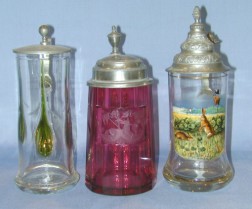 |
| Left to right, applied green glass decoration on a clear glass body; a clear blown glass stein, cranberry flashed on the interior, faceted and copper wheel etched; clear glass with an enameled scene of two rabbits in a cabbage patch! |
 |
| A clear blown glass stein, c. 1860, with a row of round "thumbprints" above the waist-line, and facet cuts around the base. |
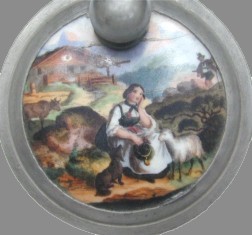 |
| This handpainted porcelain inlay provides a nice finish to the simple glass stein shown above. |
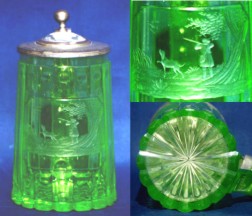 |
| An unusual glass stein colored by the addition of uranium to the glass. This stein, c. 1860, has had rounded facets cut by stone wheel, and a central panel copper wheel etched with a hunting scene. |
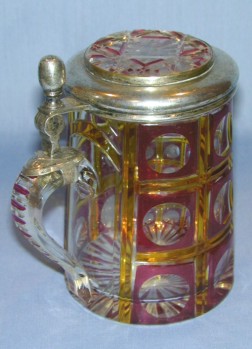 |
| An elegant clear blown glass stein with silver lid, flashed with purple, cut to clear, and further decorated with a yellow stain. Note the extra steps taken by the decorator who cut and colored both the glass inlay and the handle. |
Collectors want to know with some certainty what it is they have. We see this in the careful study of trademarks, form numbers and other markings which tell where and when an item was manufactured. There is intense interest in catalogs, which allow collectors to view their pieces as part of a greater whole, to recognize and collect related sets or series, and to pursue specific items for addition to their collections. Not only do they know what they have, they know what they don't have! And every once in a while a collector will find a piece which is not in the catalog. Could it be unique?
Collectors of glass steins don't have the luxury of well-marked pieces, and catalogs are non-existent. With the exception of pressed glass, one reason for the general absence of marks is that trademarks, signatures and other identifying marks cannot be added to glass during the manufacturing process, they would have to be added to the finished item. Many glass pieces were manufactured by one company, then finished by others, further complicating the question of marks. In addition, glass is such a flexible medium that glassblowers, cutters and engravers enjoyed exceptional freedom of artistic expression. Although many glass steins were decorated with a repeatable transfer process, further artistic freedom was exercised with hand-enameling and pewter fittings, especially the use of lids with decorated porcelain inserts, "jewels" or prisms. As a result, the glass collector has an endless variety to choose from, but must educate himself to identify the manufacturing techniques, the age characteristics and other indications of quality and value.
Gary Kirsner's "The Beer Stein Book" illustrates 239 glass steins in the section on glass, and adds color photos of 29 more, with a further 8 glass steins bearing inlaid lids in the brewery section. The techniques shown include engraving, cutting, etching, enameling, applied glass, colored glass (including milk glass), overlay or cased glass, figural and inlaid lids, and pewter overlays and collars. Decorative themes include occupationals, coats of arms, religious, remembrance, marriage, etched scenes of deer, horses, dogs, people and spas, military, student associations, athletic competition and everyday happenings. The age of the steins ranges from late 1600's to the 1920's, and the estimated values range from $100 to $10,000 and more. Of 276 items, manufacturing attribution is provided for only 4 items, and the artist is identified for only 3 decorations. What we see here is a super-rich variety, but no roadmap for the collector!
The good news in this situation for collectors is that there are many different themes around which one can build a unique collection, and there are many excellent quality steins available at lower cost than an etched Mettlach or a porcelain character. Possible themes include pre-1800; clear or colored copper wheel engraved scenes; pedestal bases; green enameled; stone wheel cut; cased or overlay; applied glass decorations; jeweled or prism lids; occupationals; brewery inlaid lids; mold-blown and enameled; Mary Gregory type; or even "1/4 liter or smaller".
The earliest glass steins, which were extremely expensive when they were created, still command high prices. Steins which show exceptional talent of the glassblower or the etcher are also very expensive. But the inability to identify and catalog most glass steins, coupled with the exceptional variety of themes around which one can build a collection, mean that many very fine pieces are available at comparatively inexpensive prices.
Glass collectors should familiarize themselves with Ron Fox's article about "Glass Techniques" in our Library.
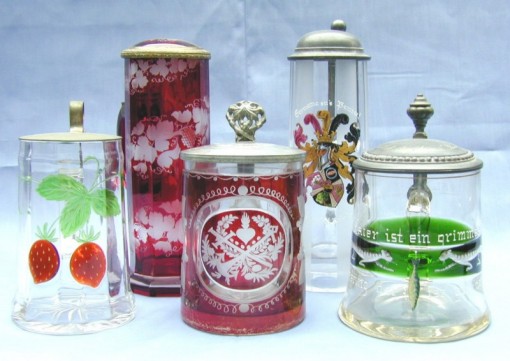 |
| From the left, a clear glass stein with applied glass decoration; two ruby flashed and cut to clear steins; an enameled student association stein; and a clear glass stein with applied glass and enameled decoration of two cats stalking a herring. |
|
All rights reserved. |